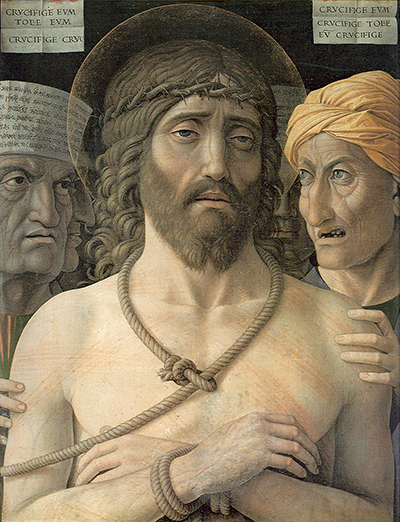Mantegna’s Ecce H*mo (Circa 1500) is a painting measuring 54 x 42 cm produced under the patronage of the Gonzago family and now housed in the Jacquemart-Andre Museum, Paris.
The medium used is open to debate and is variously described as: oil on canvas, tempera on wood panel, tempera with glue and gold on wood and Tuchlien (a method imported from the Low Countries involving a distemper technique using finely ground pigments and animal glue applied to a fine-woven linen). Mantegna is known to have employed all of these techniques.
The Ecce H*mo narrative has been the subject of many depictions by various artists from the 9th to the 20th Centuries and was particularly popular during the Italian Renaissance. When discussing Mantegna’s version of Ecce H*mo, it is important to note the vast range of other approaches to the subject. For example, there are panoramic views of the crowd from outside of the temple which shows Christ on a balcony surrounded by Roman soldiers and Jewish priests with Pontius Pilate looking on; similar scenes from the inside of the temple looking out at the crowd and more intimate scenes of the Christ figure robed, crowned and sceptred.
The theme of Ecce H*mo was also included in the work of Caravaggio, Titian, Aelbrecht Bouts, Tintoretto, Correggio, Hieronymus Bosch and Quentin Massys. In his own Ecce H*mo, Mantegna deals with the narrative in a different and innovative way. There are five figures depicted, three Hebrew priests, a grotesque woman and the figure of Christ shown naked, scourged, hands bound, a rope around his throat (held loosely by an unseen figure), flecks of blood oozing from the crown of thorns and a dimming halo above his head. In the background, two pamphlets declare the presence of the unseen crowd chanting ‘crucify him, take him and crucify him’.
The framing of the painting is very compact with characters bodies not entirely within frame. The odd use of perspective, a skill that Mantegna was particularly renowned for, also adds to the effect by almost pushing the Christ figure forward towards the viewer and onto his ‘way of sorrows’. Similarly, the odd use of chiaroscuro (light and dark) adds to the eerie effect (where is the light coming from and why is the colour of the hat so vivid?). All of these elements engage the viewer with an intimacy and intensity that is often absent from other depictions of the Ecce H*mo.
Other things to note are the sculptural / marble-like qualities of the characters produced by the use of a mono-tonal (‘grisaille’ effect) – a skill he learned from his own studies in classical antiquity and his work with Francesco Squarcione and Jacopo Bellini. Similarly the translucency of the halo, an effect known as scrumbling exhibits further evidence of his technical virtuosity. Although Andrea Mantegna's influence on art history lies mainly in the area of the fresco, paintings such Ecce H*mo have also added greatly to his legacy.




